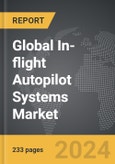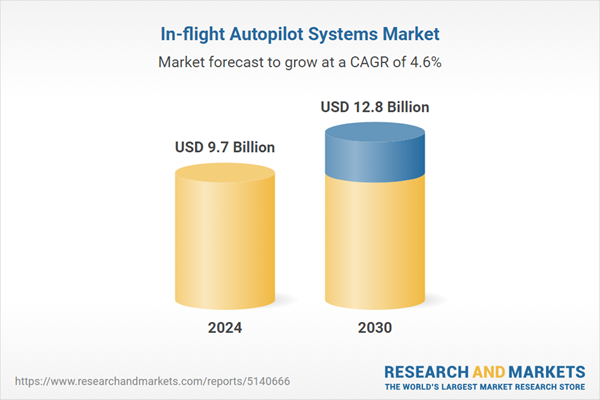The global market for In-flight Autopilot Systems was estimated at US$9.7 Billion in 2024 and is projected to reach US$12.8 Billion by 2030, growing at a CAGR of 4.6% from 2024 to 2030. This comprehensive report provides an in-depth analysis of market trends, drivers, and forecasts, helping you make informed business decisions. The report includes the most recent global tariff developments and how they impact the In-flight Autopilot Systems market.
Global In-Flight Autopilot Systems Market - Key Trends & Drivers Summarized
How Are In-Flight Autopilot Systems Advancing Modern Aviation?
In-flight autopilot systems have become indispensable in modern aviation, automating critical aspects of flight such as navigation, altitude control, and landing. These systems not only relieve pilots from constant manual operation but also enhance safety by maintaining precision during complex maneuvers. As air travel continues to grow, demand for advanced autopilot systems is rising, particularly for long-haul and commercial aircraft. Modern autopilot systems integrate cutting-edge technologies such as GPS, inertial navigation, and machine learning algorithms, enabling accurate course adjustments and enhanced performance even in adverse weather conditions. By improving both efficiency and safety, autopilot technology is central to the evolution of modern flight.What Role Do Safety Regulations Play in the Autopilot Market?
Safety is a paramount concern in aviation, with stringent regulations governing every aspect of flight systems, including autopilot technology. Regulatory bodies like the FAA and EASA mandate high standards for autopilot systems to ensure safety and reliability, particularly in commercial aviation. Compliance with these rigorous standards requires significant investment in testing, certification, and quality assurance. As new safety regulations emerge, manufacturers must continuously innovate to meet these demands, leading to more advanced autopilot systems that adhere to the latest safety requirements. This regulatory environment not only drives innovation but also solidifies autopilot systems as a critical safety feature in aircraft design.How Are Technological Innovations Shaping the Future of Autopilot?
Technological advancements are redefining the capabilities of in-flight autopilot systems, making them more adaptable and responsive to real-time flight conditions. Integrating artificial intelligence (AI) allows autopilot systems to process vast amounts of data, learn from previous flight patterns, and make informed decisions to optimize fuel efficiency and reduce operational costs. Additionally, developments in sensor technology and radar integration enable autopilot systems to detect and respond to obstacles, reducing risks and improving overall flight safety. With these innovations, the future of autopilot systems is steering towards fully autonomous flights, bringing significant changes to both commercial and cargo aviation sectors.The Growth in the In-Flight Autopilot Systems Market Is Driven by Several Factors
The growth in the in-flight autopilot systems market is driven by several factors, including increasing air traffic, stringent safety regulations, and rapid advancements in AI and sensor technology. The growing demand for efficient and reliable flight operations has made autopilot systems a necessity in commercial aviation. Regulatory standards that emphasize safety and compliance are also propelling demand, as aircraft manufacturers are required to integrate certified autopilot systems. Additionally, the development of AI-enabled and sensor-driven autopilot solutions is opening new opportunities for fully autonomous flight, appealing to both airlines and cargo operators seeking cost-effective solutions. These factors collectively underscore the critical role of autopilot systems in the future of aviation.SCOPE OF STUDY:
The report analyzes the In-flight Autopilot Systems market in terms of units by the following Segments, and Geographic Regions/Countries:- Segments: Aircraft Type (Rotary Wings Aircraft, Fixed-Wing Aircraft); Application (Commercial Aircrafts, Military Aircrafts, Civilian Aircrafts); System Type (Flight Director System, Altitude and Heading Reference System, Avionics System, Flight Control System, Other System Types)
- Geographic Regions/Countries: World; United States; Canada; Japan; China; Europe (France; Germany; Italy; United Kingdom; and Rest of Europe); Asia-Pacific; Rest of World.
Key Insights:
- Market Growth: Understand the significant growth trajectory of the Flight Director System segment, which is expected to reach US$4.5 Billion by 2030 with a CAGR of a 5.3%. The Altitude and Heading Reference System segment is also set to grow at 4.0% CAGR over the analysis period.
- Regional Analysis: Gain insights into the U.S. market, valued at $2.7 Billion in 2024, and China, forecasted to grow at an impressive 4.3% CAGR to reach $2.0 Billion by 2030. Discover growth trends in other key regions, including Japan, Canada, Germany, and the Asia-Pacific.
Why You Should Buy This Report:
- Detailed Market Analysis: Access a thorough analysis of the Global In-flight Autopilot Systems Market, covering all major geographic regions and market segments.
- Competitive Insights: Get an overview of the competitive landscape, including the market presence of major players across different geographies.
- Future Trends and Drivers: Understand the key trends and drivers shaping the future of the Global In-flight Autopilot Systems Market.
- Actionable Insights: Benefit from actionable insights that can help you identify new revenue opportunities and make strategic business decisions.
Key Questions Answered:
- How is the Global In-flight Autopilot Systems Market expected to evolve by 2030?
- What are the main drivers and restraints affecting the market?
- Which market segments will grow the most over the forecast period?
- How will market shares for different regions and segments change by 2030?
- Who are the leading players in the market, and what are their prospects?
Report Features:
- Comprehensive Market Data: Independent analysis of annual sales and market forecasts in US$ Million from 2024 to 2030.
- In-Depth Regional Analysis: Detailed insights into key markets, including the U.S., China, Japan, Canada, Europe, Asia-Pacific, Latin America, Middle East, and Africa.
- Company Profiles: Coverage of players such as Cloud Cap Technology, Inc., Esterline Technologies Corporation, Garmin Ltd., General Electric Company, Genesys Aerosystems and more.
- Complimentary Updates: Receive free report updates for one year to keep you informed of the latest market developments.
Some of the 23 companies featured in this In-flight Autopilot Systems market report include:
- Cloud Cap Technology, Inc.
- Esterline Technologies Corporation
- Garmin Ltd.
- General Electric Company
- Genesys Aerosystems
- Honeywell International, Inc.
- Lockheed Martin Corporation
- Lufthansa Systems GmbH & Co. KG
- MicroPilot Inc.
- Rockwell Collins, Inc.
This edition integrates the latest global trade and economic shifts as of June 2025 into comprehensive market analysis. Key updates include:
- Tariff and Trade Impact: Insights into global tariff negotiations across 180+ countries, with analysis of supply chain turbulence, sourcing disruptions, and geographic realignment. Special focus on 2025 as a pivotal year for trade tensions, including updated perspectives on the Trump-era tariffs.
- Adjusted Forecasts and Analytics: Revised global and regional market forecasts through 2030, incorporating tariff effects, economic uncertainty, and structural changes in globalization. Includes segmentation by product, technology, type, material, distribution channel, application, and end-use, with historical analysis since 2015.
- Strategic Market Dynamics: Evaluation of revised market prospects, regional outlooks, and key economic indicators such as population and urbanization trends.
- Innovation & Technology Trends: Latest developments in product and process innovation, emerging technologies, and key industry drivers shaping the competitive landscape.
- Competitive Intelligence: Updated global market share estimates for 2025, competitive positioning of major players (Strong/Active/Niche/Trivial), and refined focus on leading global brands and core players.
- Expert Insight & Commentary: Strategic analysis from economists, trade experts, and domain specialists to contextualize market shifts and identify emerging opportunities.
- Complimentary Update: Buyers receive a free July 2025 update with finalized tariff impacts, new trade agreement effects, revised projections, and expanded country-level coverage.
Table of Contents
I. METHODOLOGYII. EXECUTIVE SUMMARY2. FOCUS ON SELECT PLAYERSIII. MARKET ANALYSISCANADAITALYREST OF EUROPEREST OF WORLDIV. COMPETITION
1. MARKET OVERVIEW
3. MARKET TRENDS & DRIVERS
4. GLOBAL MARKET PERSPECTIVE
UNITED STATES
JAPAN
CHINA
EUROPE
FRANCE
GERMANY
UNITED KINGDOM
ASIA-PACIFIC
Companies Mentioned (Partial List)
A selection of companies mentioned in this report includes, but is not limited to:
- Cloud Cap Technology, Inc.
- Esterline Technologies Corporation
- Garmin Ltd.
- General Electric Company
- Genesys Aerosystems
- Honeywell International, Inc.
- Lockheed Martin Corporation
- Lufthansa Systems GmbH & Co. KG
- MicroPilot Inc.
- Rockwell Collins, Inc.
Table Information
| Report Attribute | Details |
|---|---|
| No. of Pages | 233 |
| Published | July 2025 |
| Forecast Period | 2024 - 2030 |
| Estimated Market Value ( USD | $ 9.7 Billion |
| Forecasted Market Value ( USD | $ 12.8 Billion |
| Compound Annual Growth Rate | 4.6% |
| Regions Covered | Global |









